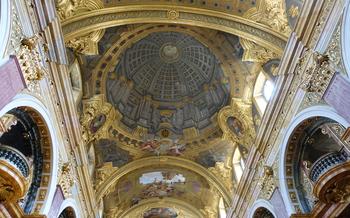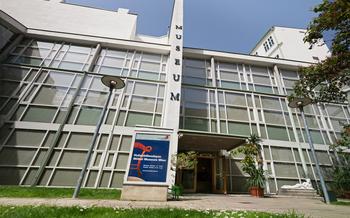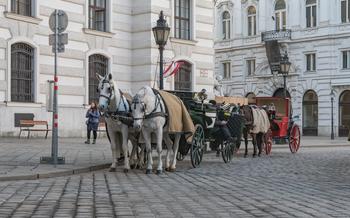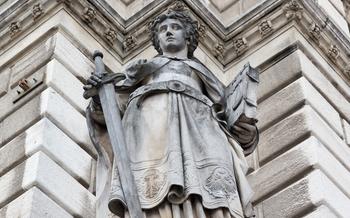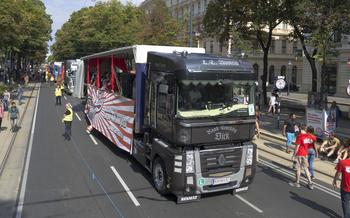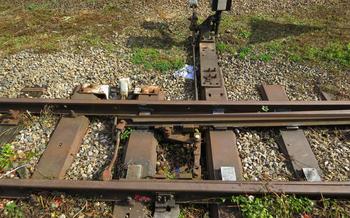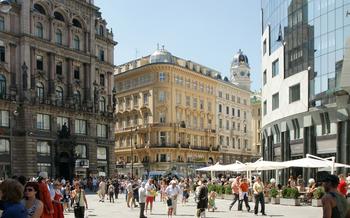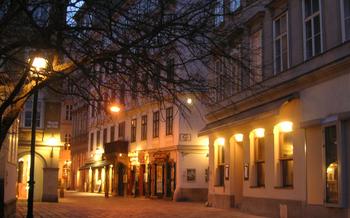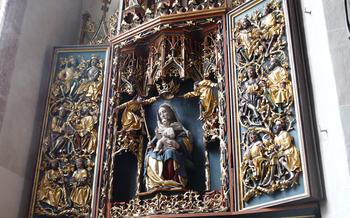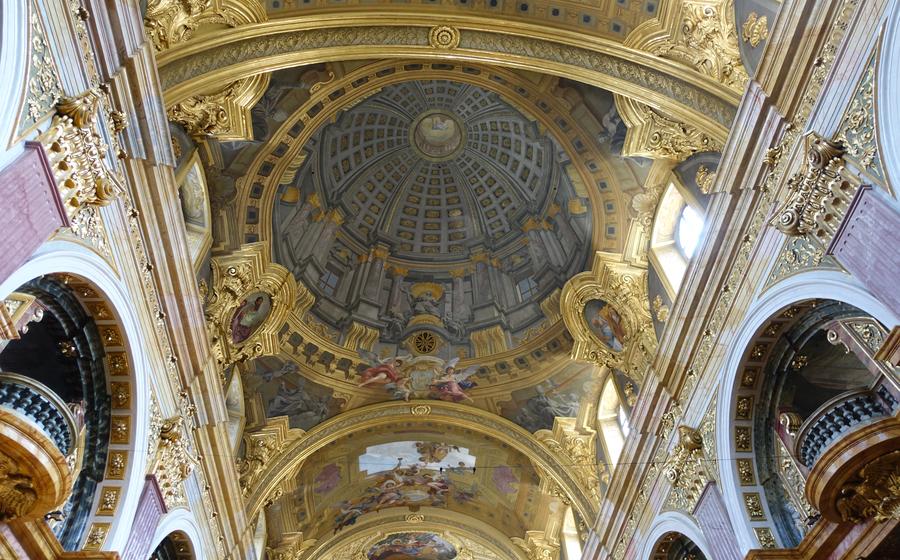
Jesuit Church, Vienna
- Jesuit Church, Vienna: An Architectural Masterpiece
- The Magnificent Facade of the Jesuit Church
- Stepping Inside the Jesuit Church
- The High Altar: A Work of Art
- Exploring the Side Chapels
- The Jesuit Church as a Cultural Venue
- Transportation Options to Reach the Jesuit Church
- Nearby Attractions and Points of Interest
- Suggested Itineraries for Exploring the Area
- Tips for Photography Enthusiasts
- Exterior Photography
- Interior Photography
- Capturing Details
- Recommended Camera Settings
- Local Cuisine and Dining Options
- Shopping Opportunities Near the Jesuit Church
- Insider Tip: Hidden Gems and Local Secrets
Jesuit Church, Vienna: An Architectural Masterpiece
Nestled in the heart of Vienna, the Jesuit Church stands as a testament to the grandeur of Baroque architecture. Its construction began in the 17th century under the patronage of Emperor Ferdinand II, reflecting the power and influence of the Jesuit order during the Counter-Reformation. The church's striking facade features intricate sculptures and symbolic imagery, showcasing the Baroque style's penchant for elaborate ornamentation. The interior of the church is equally impressive, boasting a grandiose nave, ornate ceiling frescoes, and stunning side chapels. The Jesuit Church is a masterpiece of Baroque architecture, attracting visitors from around the world who come to admire its beauty and historical significance. Its location in the city center, adjacent to the Hofburg Palace, makes it easily accessible and a must-visit destination for anyone exploring Vienna.
The Magnificent Facade of the Jesuit Church
As you approach the Jesuit Church, its grand facade is a sight to behold, showcasing the epitome of Baroque architectural prowess. The intricate details and symbolic imagery adorning the facade captivate the eyes and provide a glimpse into the rich history and religious significance of the church.
The facade's imposing presence is defined by its two towering bell towers, reaching towards the sky like celestial beacons. Each tower is adorned with intricate carvings and sculptures, depicting biblical scenes and allegorical figures, creating a harmonious blend of art and architecture.
At the center of the facade, above the main entrance, stands a captivating sculptural ensemble, narrating the story of the Jesuit order's founding. The dynamic figures, frozen in motion, convey a sense of drama and devotion, inviting visitors to step inside and delve deeper into the church's captivating interior.
The facade's architectural style is a testament to the Baroque period's grandeur and exuberance. Every inch of the surface is adorned with intricate carvings, cherubs, and decorative elements, creating a symphony of visual delight. The harmonious interplay of curves, arches, and columns lends a sense of movement and dynamism to the facade, captivating the viewer's gaze.
Comparisons with other Baroque churches reveal the Jesuit Church's unique character. While sharing certain stylistic elements, such as the elaborate ornamentation and sculptural details, the Jesuit Church stands out with its distinctive composition and iconography. Its facade reflects the unique identity and mission of the Jesuit order, emphasizing themes of faith, learning, and devotion.
Stepping Inside the Jesuit Church
As you step through the grand entrance of the Jesuit Church, you are immediately struck by the awe-inspiring grandeur of the nave. Towering columns adorned with intricate carvings soar towards the heavens, creating a sense of verticality that is both majestic and humbling. The ceiling is a masterpiece in itself, adorned with elaborate frescoes depicting scenes from the life of Jesus and the saints. The vibrant colors and skillful brushstrokes bring the biblical narratives to life, inviting visitors to contemplate the sacred stories that have shaped Christianity for centuries.
The side chapels, each dedicated to a different saint or theme, offer a more intimate and contemplative experience. Intricate carvings, delicate frescoes, and stunning stained glass windows adorn these sacred spaces, creating an atmosphere of reverence and tranquility. The side chapels serve as a reminder of the rich diversity of the Catholic faith and the countless individuals who have dedicated their lives to serving God and humanity.
The High Altar: A Work of Art
As you step closer to the altar, the intricate details become even more apparent. The central figure of Saint Ignatius Loyola, the founder of the Jesuit order, stands tall and majestic, surrounded by a symphony of carvings and marble work. The intricate carvings depict scenes from the life of Saint Ignatius, as well as allegorical figures representing virtues and religious concepts.
The marble work is equally impressive, with delicate veins and patterns swirling across the surface. The altar is a testament to the skill and artistry of the Baroque era, where every detail was meticulously crafted to create a sense of awe and wonder.
The symbolism and religious iconography of the high altar are deeply intertwined. The central figure of Saint Ignatius represents the foundation of the Jesuit order and its commitment to education, spirituality, and service. The surrounding carvings and sculptures depict scenes from the life of Christ, the Virgin Mary, and other saints, emphasizing the rich theological and historical narratives that underpin the Catholic faith.
Overall, the high altar of the Jesuit Church is a masterpiece of Baroque art and a significant symbol of the Jesuit order's legacy in Vienna. Its intricate carvings, marble work, and religious iconography combine to create a breathtaking spectacle that leaves visitors in awe of its beauty and grandeur.
Exploring the Side Chapels
The Jesuit Church boasts several side chapels, each dedicated to a different saint and adorned with unique architectural features. The Chapel of St. Francis Xavier, for instance, showcases intricate marble work and delicate sculptures depicting scenes from the saint's life. The Chapel of the Immaculate Conception, on the other hand, features a stunning altarpiece dedicated to the Virgin Mary, surrounded by ornate carvings and gold leaf embellishments.
The Chapel of St. Ignatius of Loyola, the founder of the Jesuit order, is particularly noteworthy for its elaborate artwork and historical significance. Its walls are adorned with frescoes depicting the life of St. Ignatius, while the altar features a majestic statue of the saint himself. The chapel serves as a testament to the profound influence of the Jesuit order on the church's history and spirituality.
Each side chapel offers its own unique charm and historical significance, inviting visitors to delve deeper into the rich tapestry of the Jesuit Church.
The Jesuit Church as a Cultural Venue
Beyond its religious significance, the Jesuit Church serves as a vibrant cultural venue, hosting a diverse range of events that showcase the city's rich artistic heritage. The church's exceptional acoustics and grand interior provide an ideal setting for classical music concerts, which are held regularly, featuring renowned orchestras and soloists performing a wide repertoire of classical masterpieces. Organ recitals and choral performances further enhance the church's musical legacy, offering visitors a chance to experience the sacred space's resonant atmosphere.
In addition to musical events, the Jesuit Church also hosts special exhibitions and cultural programs. These events often delve into the church's history, showcasing its architectural and artistic treasures through guided tours, lectures, and interactive displays. The church's versatile space allows for a variety of exhibitions, ranging from contemporary art installations to historical artifacts, providing visitors with a unique perspective on Vienna's cultural landscape.
As a hub for cultural enrichment, the Jesuit Church offers a welcoming space for individuals to connect, engage, and appreciate the arts. Its diverse programming ensures that there is something for everyone, making it a must-visit destination for both locals and tourists seeking a deeper immersion in Vienna's vibrant cultural scene.
Transportation Options to Reach the Jesuit Church
Conveniently located in the heart of Vienna's city center, the Jesuit Church is easily accessible by various transportation options.
-
Public Transportation: The church is well-connected to Vienna's extensive public transportation network. Take the U3 subway line and alight at the Herrengasse station, which is just a short walk from the church. Alternatively, numerous bus lines, including the 1A, 2A, and 3A, stop within walking distance of the Jesuit Church.
-
Metro Stations: The nearest metro station to the Jesuit Church is Herrengasse, served by the U3 line. From here, it is a leisurely stroll of about 200 meters to reach the church.
-
Parking Options: For those arriving by car, limited street parking is available in the vicinity of the church. However, it is recommended to use public transportation or park in one of the nearby parking garages to avoid the hassle of finding a spot.
Nearby Attractions and Points of Interest
Within a short walking distance from the Jesuit Church, visitors can discover a wealth of other attractions that showcase Vienna's rich history and cultural heritage. The Hofburg Palace, the former imperial residence of the Habsburg dynasty, is a must-see for any visitor to the city. This sprawling complex houses several museums, including the Imperial Apartments and the Sisi Museum, dedicated to the life of Empress Elisabeth.
Adjacent to the Hofburg is the world-renowned Spanish Riding School, home to the famous Lipizzaner horses. Visitors can witness the grace and precision of these majestic animals during regular performances or take a guided tour of the stables.
Art enthusiasts will appreciate the Albertina Museum, which houses a vast collection of graphic art, including works by Dürer, Rembrandt, and Picasso. The museum's collection of over one million prints and drawings is one of the largest in the world.
For a relaxing stroll or a picnic, the Volksgarten Park offers a tranquil oasis in the heart of the city. This beautifully landscaped park features manicured gardens, a rose garden, and a monument to the composer Johann Strauss.
Nature enthusiasts should not miss the Natural History Museum, which houses a vast collection of exhibits on the natural world. Highlights include a dinosaur skeleton, a collection of meteorites, and a life-size model of a blue whale.
Suggested Itineraries for Exploring the Area
Depending on your time and interests, there are several ways to explore the Jesuit Church and its surroundings. Here are two suggested itineraries:
Half-Day Itinerary Focusing on the Jesuit Church:
- Morning: Start your day with a visit to the Jesuit Church. Take your time to admire the stunning facade, step inside to explore the grandiose nave, intricate side chapels, and magnificent high altar.
- Afternoon: After immersing yourself in the church's history and beauty, head to the nearby Volksgarten Park for a leisurely stroll. Explore the park's beautiful gardens, admire the sculptures, and relax by the fountain.
Full-Day Itinerary Exploring the Surrounding Attractions:
- Morning: Begin your day with a visit to the Jesuit Church, following the same itinerary as above.
- Afternoon: After lunch, visit the Hofburg Palace, the former imperial residence of the Habsburg dynasty. Explore the palace's grand state rooms, museums, and treasury.
- Evening: Conclude your day with a performance at the Spanish Riding School, where you can witness the world-famous Lipizzaner horses performing their elegant dressage routines.
Combining the Jesuit Church with Other Nearby Landmarks:
The Jesuit Church is conveniently located near several other notable landmarks, allowing you to combine your visit with other attractions. Here are a few suggestions:
- Albertina Museum: Home to a vast collection of graphic art, including works by Dürer, Michelangelo, and Picasso.
- Natural History Museum: Explore the wonders of the natural world through exhibits on dinosaurs, wildlife, and minerals.
- Museumsquartier: A vibrant cultural hub with museums, galleries, and performance spaces.
Tailor your itinerary based on your interests and time constraints to make the most of your visit to the Jesuit Church and the surrounding area.
Tips for Photography Enthusiasts
The Jesuit Church presents a treasure trove of photographic opportunities for enthusiasts. Capturing the grandeur of its exterior and intricate details of its interior requires careful planning and technical skill.
Exterior Photography
For exterior shots, consider the time of day. Early morning or late afternoon sunlight casts a warm glow on the church's facade, highlighting its sculptures and architectural features. Use a wide-angle lens to capture the full scale of the building against the Viennese sky.
Interior Photography
Inside the church, natural light is limited. Use a tripod to steady your camera and avoid blurry images. Employ a wide aperture to let in more light and capture the details of the frescoes and carvings.
Capturing Details
To capture the intricate details of the church's interior, such as the sculptures on the side altars or the ornate ceiling frescoes, use a macro lens. This will allow you to get close-up shots that reveal the craftsmanship and artistry of these elements.
Recommended Camera Settings
For optimal results, set your camera to a low ISO to minimize noise. Use a shutter speed that allows you to capture sharp images without motion blur. For exterior shots, a shutter speed of around 1/125th of a second should suffice. For interior shots, you may need to use a slower shutter speed, such as 1/30th of a second, and a tripod to avoid camera shake.
By following these tips, you can create stunning photographs that capture the beauty and majesty of the Jesuit Church, preserving its grandeur for years to come.
Local Cuisine and Dining Options
When exploring the area around the Jesuit Church, visitors have a wealth of dining options to choose from. For those seeking a taste of traditional Austrian cuisine, the nearby restaurants offer a delectable array of dishes. From hearty Viennese Schnitzel to flavorful Tafelspitz (boiled beef), there are culinary delights to satisfy every palate.
International cuisine enthusiasts will also find a range of options to suit their preferences. From Italian trattorias to Asian fusion restaurants, the area offers a diverse culinary landscape. There are also numerous cafés and pastry shops where visitors can enjoy a quick bite or indulge in Viennese specialties like Sachertorte and Apfelstrudel.
When it comes to dining recommendations, the Gastwirtschaft Wratschko is a must-visit for traditional Austrian fare. Its cozy atmosphere and authentic dishes have earned it a reputation among locals and tourists alike. For a more upscale experience, the Restaurant Steirereck, located in the nearby Stadtpark, offers a modern take on Austrian cuisine with a focus on seasonal and regional ingredients.
For those seeking a casual and affordable option, the Naschmarkt, Vienna's largest market, is a great place to sample a variety of street food and local delicacies. With over 100 stalls offering everything from fresh produce to international cuisine, the Naschmarkt is a foodie's paradise.
A trip to Vienna is not complete without trying the iconic Viennese coffee culture. Cafés like Café Central and Café Sacher are renowned for their elegant ambiance, delicious pastries, and expertly brewed coffee. Whether you're looking for a quick pick-me-up or a leisurely afternoon indulging in Viennese café culture, these establishments are not to be missed.
Shopping Opportunities Near the Jesuit Church
Within a short walk from the Jesuit Church, visitors will find a variety of shopping options to suit their needs. For those seeking unique souvenirs and handmade crafts, boutiques and souvenir shops abound, offering a range of traditional Austrian items, including intricate glassware, hand-painted ceramics, and charming cuckoo clocks. Local markets and flea markets, such as the Naschmarkt or the Flohmarkt am Donaukanal, provide an excellent opportunity to find one-of-a-kind treasures, vintage clothing, and antiques.
For those looking for a wider selection, department stores like Steffl Department Store or Gerngross offer a comprehensive range of fashion, accessories, and home goods. Whether seeking high-end luxury brands or affordable everyday items, visitors are sure to find something to their liking. Exploring the charming streets surrounding the Jesuit Church, one can discover hidden gems such as specialty shops selling artisanal chocolates, gourmet coffee, or traditional Viennese pastries.
When shopping in Vienna, it's worth taking the time to savor the experience. Many shops are family-run businesses that have been passed down through generations, offering a personal touch and a wealth of knowledge about their products. Don't hesitate to engage with the friendly locals, who are always happy to share their recommendations and insights into Viennese culture.
Insider Tip: Hidden Gems and Local Secrets
Beyond the iconic facade and grand interior of the Jesuit Church, Vienna offers a treasure trove of hidden gems and local secrets just waiting to be discovered. Explore the intricate network of secret passageways and underground tunnels that lie beneath the city, offering a glimpse into Vienna's rich history and urban legends. Seek out hidden courtyards and gardens tucked away from the bustling streets, providing tranquil oases for relaxation and contemplation.
Venture off the beaten path to uncover lesser-known attractions near the church, such as the charming Griechenbeisl, Vienna's oldest tavern, steeped in literary history and local lore. Discover unique boutiques and ateliers showcasing the works of local artists and craftspeople, offering one-of-a-kind souvenirs and handmade treasures. Immerse yourself in the local culture by attending traditional Viennese events, such as the annual Heurigen festivals, where you can savor local wines and culinary delights while enjoying live music and dancing.
To truly experience Vienna like a local, engage with the friendly residents, who are always willing to share their insider tips and recommendations. Ask for their favorite hidden spots, local markets, and authentic restaurants to get a taste of the city's vibrant culinary scene. Embrace the opportunity to learn a few German phrases to connect with the locals and enhance your overall experience.
